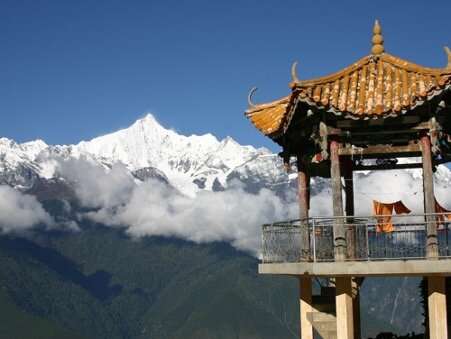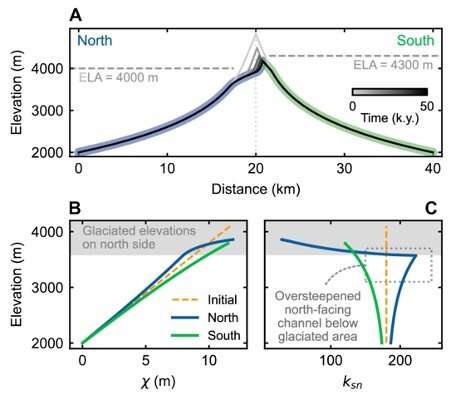July 19, 2023 feature
This article has been reviewed according to Science X's editorial process and policies. Editors have highlighted the following attributes while ensuring the content's credibility:
fact-checked
peer-reviewed publication
trusted source
proofread
Asymmetry in China's mountain glaciers irreversibly changes the landscape

Earth has experienced significant changes in its climate over the past ~2.6 million years (the Quaternary) with a series of glacial and interglacial cycles that have transformed our landscapes. This involves erosive action directly from glaciers moving across the area, as well as fluvial erosion from subsequent meltwater. In particular, mountain glaciers can erode the local landscape, changing the topography over which water runs downstream, but it is uncertain how quickly such activity has an impact.
New research, published in Geology, has focused on the Qilian Shan mountain range in China as an ideal experiment to determine the effects of glacier erosion on mountain topography due to the difference in glacier size on either side of the mountain. Solar insolation from the sun focuses more on the southern flank of the mountain, meaning that glaciers grow to a smaller size than the comparatively cooler and wetter (from Asian monsoons) northern slopes, a result known as asymmetric glaciation. In fact, the point at which ice accumulation and ice melt is in equilibrium (known as equilibrium line altitude) on the northern slopes is 200m lower than on the southern slopes.
Dr. Jingtao Lai and Dr. Kimberly Huppert, from the GFZ German Research Center for Geosciences, explain that this phenomenon is not a recent occurrence, instead asymmetric glaciation is likely to have occurred since the late Oligocene (up to 27.8 million years ago) as the East Asian monsoon has persisted since then.
"Many glaciers are shrinking as a result of climate change, yet their potential impact on the landscapes is still unclear," Dr. Lai says. "By studying the Qilian Shan, we found that glacial erosion influenced rivers downstream, causing long-lasting changes that keep shaping the terrain even after the glaciers are gone. This understanding helps us see how climate changes affect Earth's landscapes and gives us valuable insights into how glaciers, rivers and land surface all work together in the past and potentially in the future."
To test the response of topography to glacial-interglacial cycles, the researchers used topography maps and simulated glaciation across the study area based upon different equilibrium line altitudes. The greater the difference between the equilibrium line altitudes on either slope, the more pronounced the glacial asymmetry and therefore the drainage divide moved further.

Dr. Lai and Dr. Huppert found that the drainage divide, the boundary between two neighboring drainage basins into which all of the precipitation and runoff flows, moved southwards and consequently river channels flowing into it had become steeper, noticeably on northern slopes. Such steepening results in deeper erosive action of the local landscape, not just confined to areas experiencing glaciation, but further downstream too.
The response time of the topography rebalancing itself post-glaciation results from the difference between erosion rate and the rate at which the land uplifts. Dr. Lai and Dr. Huppert's modeling suggests that while erosion is exacerbated during interglacial periods, over time erosion and uplift come to relative equilibrium, potentially taking over 6 million years. This completely outpaces the altering glacial and interglacial cycles every 40,000 and 100,000 years. Dr. Lai says that "the long response time suggests that the impact of asymmetric glaciation (via divide migration) does not disappear easily after glaciers have disappeared."
"In fact, fluvial erosion is still the dominant process in interglacial times, and divide migration impacts topography evolution via changing the rate of fluvial erosion," Dr. Lai adds. "The long response time means that the effects of drainage divide migration and erosion rate changes do not easily go away and the topography continues adjusting itself to deglaciation. This has implications for interpreting some observational data. For example, we should be careful about interpreting some observed erosion rates as long-term stable rates and assuming these rates do not change in the future.
"In this work, we only focused on the timescale of topography rebalancing itself during interglacial periods in response to asymmetric glaciation. In the future I would like to have a thorough understanding of the timescale of asymmetric glaciation moving the drainage divide location. This way we could have a full picture of the dynamic interactions between glaciers, rivers, and topography during the glacial-interglacial cycle."
Globally, this research is important to link with east-west trending mountain ranges that experience significant differences in solar insolation on its northern and southern slopes, as well as those with wind and precipitation patterns that focus more on one slope than the other. The rate at which glacial and fluvial erosion affects local landscapes is important as climate change continues to shrink glaciers and larger volumes of meltwater are transported downstream, making their mark on the environment and communities in their path.
More information: Jingtao Lai et al, Asymmetric glaciation, divide migration, and postglacial fluvial response times in the Qilian Shan, Geology (2023). DOI: 10.1130/G51086.1
Journal information: Geology
© 2023 Science X Network




















